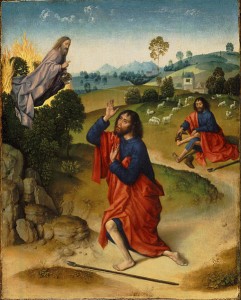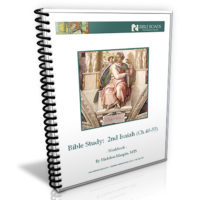
Attributed to Dierick Bouts the Elder, Nethderlands, 1447 – Moses and the Burning Bush, with Moses Removing His Shoes
It’s summertime! * And with it come visions of barbecues, long summer days, walks in the woods and glorious starry nights.
All these powerful aspects of nature have been a focus the past few months while preparing three talks for a Bible conference on Scriptural Metaphors in Nature. What a powerful topic and the two brief pieces for the June newsletter are glimpses into lessons learned. If you too love the Psalmist’s cry: “Heaven is declaring God’s glory; the sky is proclaiming his handiwork” (Ps. 19:1, Common English Bible), sit back and read on.
When you think of ‘fire’ in the Bible, you might go to its utility as a means of cooking, creating tools or heating homes. Such uses are reasonable and common. But it is the Bible’s metaphorical use of fire that reveals a two-part pattern of affliction and purification, devastation and deliverance.
Such meanings grow out of the literal nature of fire as a changing form of matter whose chemical reactions make it self-perpetuating. In other words, fire keeps burning as long as it has fuel and oxygen to feed it.
Wow. Those ancient Biblical writers zeroed in with laser insight on fire’s ‘self-perpetuating’ characteristic and saw its too frequent counterpart in human nature’s worst characteristics running unchecked. Isa. 9:18 describes how ‘wickedness burned like a fire.’ Since “wicked” isn’t a word often used today, substitute its 21st century similarities– anything criminal, barbarous, illegal, despicable, odious and outrageous. Doesn’t such behavior, usually designed to produce ‘shock and awe,’ show itself daily in the worst kind of self-indulgence?
Yet this is precisely what the prophet understood when he declares in the next verse (Isa. 9:19) that ‘the people became like fuel for the fire; no one spared another.’ Besides originating the English expression, ‘adding fuel to the fire,’ Isaiah captures how the darkest aspects of human nature feed division, immorality, discontent.
The Bible never leaves us at this description of the problem but lifts to the answer. Its many references to fire often include the concept of sacrifice. What must be relinquished in order to have the fire of inspiration burn instead?
In Abraham’s case, it seemed to be doubt that needed sacrificing. In its place, Abraham was learning to trust in the very God that had provided his son Isaac; that somehow this God wouldn’t be like the quixotic tribal gods surrounding his people, governing by whim and vendetta. Rather Abraham was finding God could be counted on to consistently bless not punish His offspring. A ram was supplied instead of a son as an appropriate sacrifice on this open fire of spiritual lesson-learning.
Most frequently, the Scriptures indicate that fire represented the presence of God, often through theophany’s (or ‘God-appearing’s’). Two vivid examples involving fire were the burning bush appearing to Moses, and the pillar of fire that led the children of Israel through the wilderness.
A revealing exercise is to look for the Biblical uses of fire and see what it represents: sacrifice, God’s presence, purification or something else. As we discover such specific examples throughout the Old Testament, the New Testament’s Pentecostal moment of ‘tongues of fire’ (Acts 2:3) takes on fresh meaning. And as you explore, we’d love to hear what you’re discovering so please share with Bible Roads’ readers.
Watch for the release on streaming video of the complete three talks on the Bible and nature, coming July 1st under the title: “Spiritual Sustainability: A Biblical Perspective”. And now for that walk in the woods…
- At least in North America, so my apologies to our friends in Australia and New Zealand.




Tongues of fire as in Acts 2: And there appeared unto them cloven tongues like as of fire, and it sat upon each of them. And they were all filled with the Holy Ghost, and began to speak with other tongues, as the Spirit gave them utterance” (KJV) This is the only use of “tongues of fire” in the Bible. I don’t think it means the fire looked like tongues. Cloven is divided…partitioned…the glory of God was distributed, imparted to all to be seen by each person. I think it is a reminder of what Moses saw in the burning… Read more »